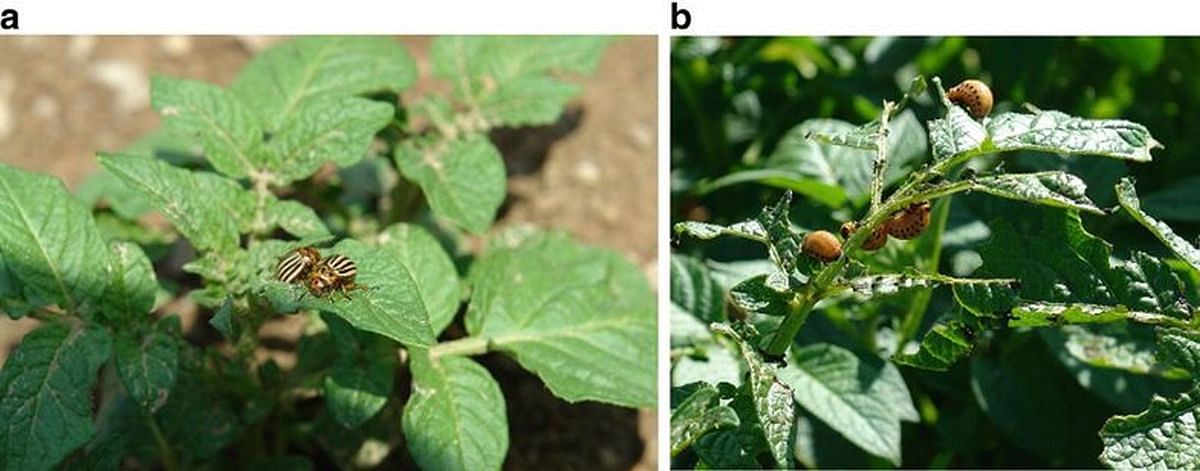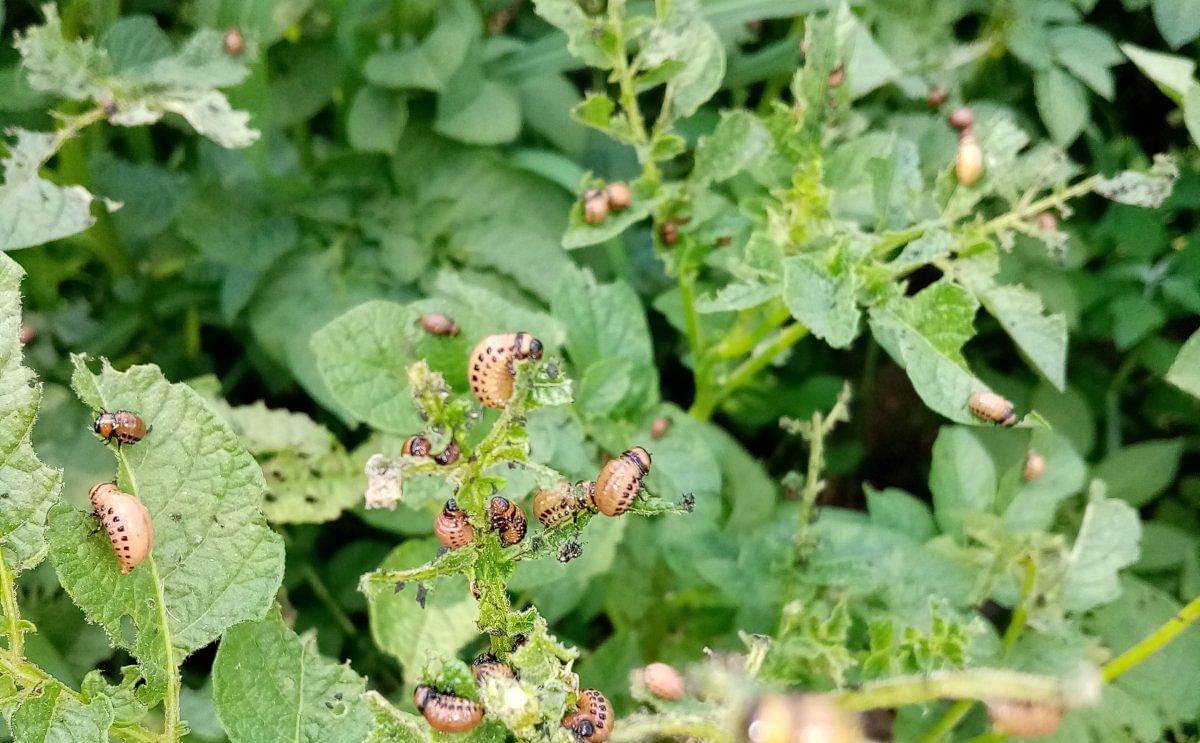Scientific description of the Colorado Potato Beetle (2020)
Based on J. Kroschel. et al. (2020) Insect Pests Affecting Potatoes in Tropical, Subtropical, and Temperate Regions. In: Campos H., Ortiz O. (eds) The Potato Crop. Springer, Cham
The authors of this content are Jürgen Kroschel, Norma Mujica, Joshua Okonya, Andrei Alyokhin
Leptinotarsa decemlineata (Say) (Coleoptera: Chrysomelidae)
Distribution
The Colorado potato beetle Leptinotarsa decemlineta is native to Mexico (image below), but has spread to Central America, most of the United States (except Alaska, California, Hawaii, and Nevada), and to southern Canada. This pest has also been introduced into Europe and parts of Asia (CABI 2017a; Jacques and Fasulo 2015).

Colorado potato beetle, Leptinotarsa decemlineata, adults (a) and larvae feeding on potato leaves (b). (Courtesy: Andrei Alyokhin)
Host range
Colorado potato beetle is an oligophagous species feeding on about ten species of plants in the family Solanaceae (Alyokhin et al. 2013). These include potato, tomato, and eggplant.
Symptoms of infestation
Both adults and larvae are voracious leaf feeders and can completely defoliate potato plants. In rare cases, tubers exposed at the soil surface can also be eaten. Characteristic black and sticky excreta is left on the stem and leaves by the larvae and adults.

Colorado Potato Beetle in larvae stadium.
Impacts on production losses
L. decemlineata is one of the most economically important insect pests of potato. Adults and larvae reduce potato tuber yields by devouring foliage. Larvae may defoliate potato plants resulting in yield losses of up to 100% if the damage occurs prior to tuber formation.
Losses in potato are most severe if the incidence of last instar larvae, the most voracious stage, peaks during the time of tuber formation. This species is a huge pest problem and farmers spend millions of dollars each year on insecticides to control it (CABI 2017a; Jacques and Fasulo 2015).
Methods of prevention and control
IPM programs against this potato pest emphasize reducing insect pest populations by using several control measures, including crop rotation, altered planting dates (to avoid peak pest populations during vulnerable stages of crop development), and use of B. thuringiensis toxins or other pesticides when economic injury levels are reached.
IPM approaches seek to maximise the impact of naturally occurring biological control agents in suppressing beetle populations (CABI 2017a; Jacques and Fasulo 2015; Laznik et al. 2010; Capinera 2001; Ferro 2000).
- Sampling.
Entire plants should be examined for above-ground life stages of the insect. Adult beetles are attracted to the yellow color and can be captured with traps. However, traps are seldom used because the various life stages are clearly distinguishable from each other. - Cultural control.
The Colorado potato beetle may be managed culturally by crop rotation. Distances of at least 0.5 km between potato fields are required to provide protection. Beetles initially disperse by walking, so crop rotation and/or trenching can significantly reduce field infestations.
Destruction of crop debris after harvest may contribute to reducing beetle populations. Beetle densities are also often lower on mulched potato plots (Alyokhin 2009). - Biological control.
While many natural enemies have been identified, they are usually not able to control Colorado potato beetle populations below the economic injury levels. The tachinid fly Myiopharus doryphorae (Riley) may produce high parasitism rates early in the season and prevent the beetles from becoming a serious pest.
Also, the entomopathogenic nematodes (Steinernema feltia Filipjev) and the fungus Beauveria bassiana have been reported to offer some control against this pest (Alyokhin 2009). - Biopesticides.
Abamectins and spinosins generally provide excellent control of this pest (but see cautionary note on insecticide resistance below). Bacterial insecticides based on delta endotoxin of bacterium Bacillus thuringiensis subsp. tenebrionis are also effective, but they must be applied against the first two instars. - Chemical control.
Insecticides are commonly used to control populations of Colorado potato beetle. Resistance to insecticides develops very rapidly in this species. For example, for endrin the first failure was reported after 1 year of its use, while for oxamyl it was observed already within the first year of use (Forgash 1985).
Overall, failures were reported to 51 compounds belonging to ten chemical groups and possessing eight modes of action (Alyokhin et al. 2013).
